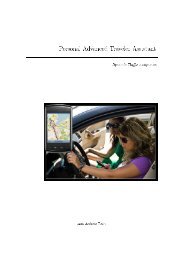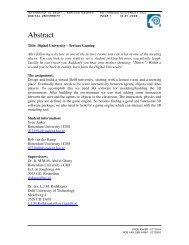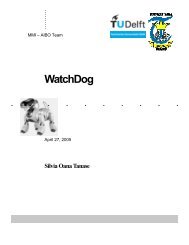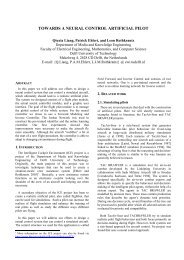Recognition of facial expressions - Knowledge Based Systems ...
Recognition of facial expressions - Knowledge Based Systems ...
Recognition of facial expressions - Knowledge Based Systems ...
You also want an ePaper? Increase the reach of your titles
YUMPU automatically turns print PDFs into web optimized ePapers that Google loves.
Principal Component Analysis<br />
The need for the PCA technique came from the fact that it was necessary to have a<br />
classification mechanism for handling special areas on the surface <strong>of</strong> the face. There were<br />
three areas <strong>of</strong> a high importance for the analysis. The first is the area between the<br />
eyebrows. For instance, the presence <strong>of</strong> wrinkles in that area can be associated to the<br />
tension in <strong>facial</strong> muscles ‘Corrugator supercilii’/’Depressor supercilii’ and so presence <strong>of</strong><br />
Action Unit 4, for the ‘lowered brow’ state. The second area is the nasolabial area. There<br />
are certain <strong>facial</strong> muscles whose changes can produce the activation <strong>of</strong> certain Action<br />
Units in the nasolabial area. The Action Unit 6 can be triggered by tension in <strong>facial</strong><br />
muscle ‘Orbicularis oculi, pars orbitalis’. In the same way, tension in <strong>facial</strong> muscle<br />
‘Levator labii superioris alaquae nasi’ can activate Action Unit 9 and strength <strong>of</strong> <strong>facial</strong><br />
muscle ‘Levator labii superioris’ can lead to the activation <strong>of</strong> Action Unit 10.<br />
The last visual area analyzed through the image processing routines is that <strong>of</strong> the chin.<br />
The tension in the <strong>facial</strong> muscle ‘Mentalis’ is associated to the presence <strong>of</strong> Action Unit<br />
17, ‘raised chin’ state.<br />
The PCA technique was used to process the relatively large images for the described<br />
<strong>facial</strong> areas. The size <strong>of</strong> each area was expressed in terms <strong>of</strong> relative value comparing to<br />
the distance between the pupils. That was used for making the process robust to the<br />
distance the person stands from the camera, and person-independent.<br />
The analyze was done separately, for each <strong>facial</strong> area. Every time there was available a<br />
set <strong>of</strong> 485 n-size vectors where n equals the width <strong>of</strong> the <strong>facial</strong> area multiplied by the<br />
height. In the common case, the size <strong>of</strong> one sample vector is <strong>of</strong> the order <strong>of</strong> few thousand<br />
values, one value per pixel. The <strong>facial</strong> image space was highly redundant and there were<br />
large amounts <strong>of</strong> data to be processed for making the classification <strong>of</strong> the desired<br />
emotions. Principal Components Analysis (PCA) is a statistical procedure which rotates<br />
the data such that maximum variability is projected onto the axes. Essentially, a set <strong>of</strong><br />
correlated variables are transformed into a set <strong>of</strong> uncorrelated variables which are ordered<br />
by reducing variability. The uncorrelated variables are linear combinations <strong>of</strong> the original<br />
variables, and the last <strong>of</strong> these variables can be removed with minimum loss <strong>of</strong> real data.<br />
- 40 -
















